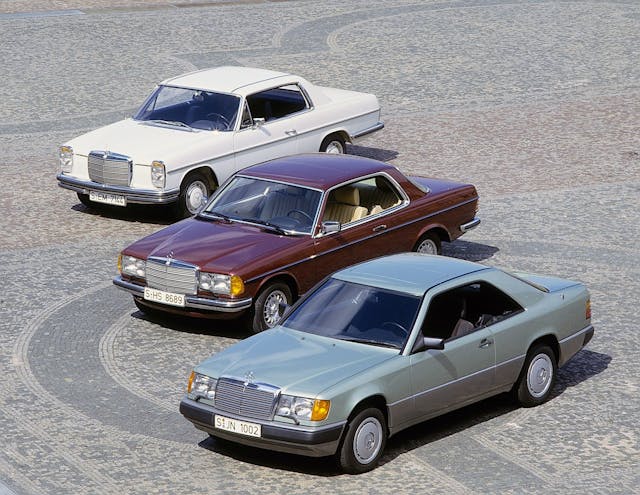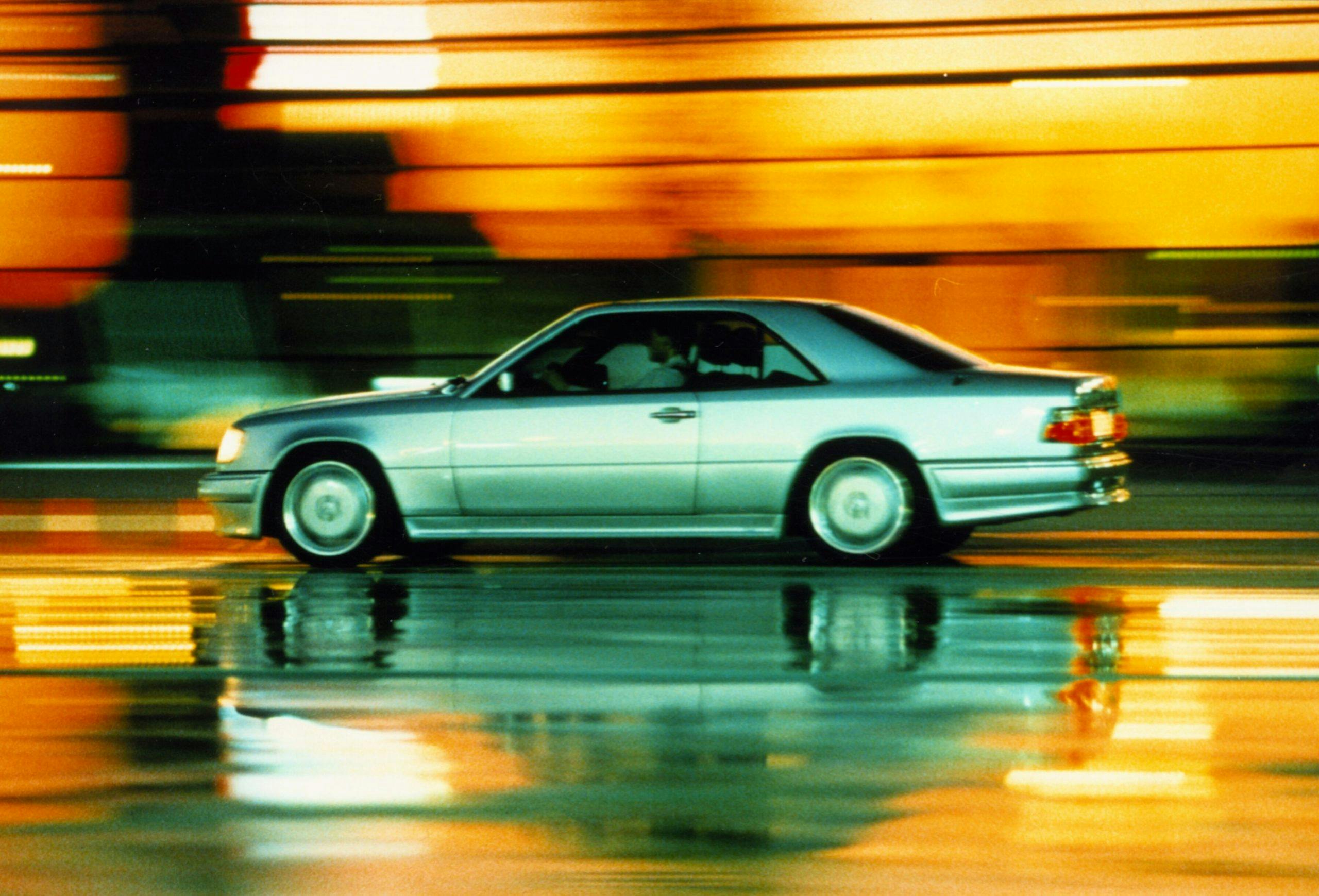Media | Articles
Which is the best Mercedes-Benz E-Class two-door?
Mercedes-Benz did not make a cabriolet version of its upper mid-range E-Class until the 124 Series of 1991, yet two-door hardtops have been a part of the lineup since 1968. Since their introduction, E-Class sedans may have been the preferred rides of European taxi drivers, but those buying a mid-size Mercedes for the joy of driving started off with the Series 114 Stroke-8 Coupés. These vehicles represented Paul Bracq’s clean design language at its best.

Stroke-8 Coupés featured a more inclined glasshouse compared to the sedans, resulting in a 1.8-inch lower roofline with no B-pillars for that elegant, frameless look. Inside, sportiness met luxury with wood veneer and extra carpeting all around.
Presented at the Hockenheimring and only available with six-cylinder engines, the new two-doors of 1968 also played an important role in Mercedes-Benz’s early ABS development. Such improved braking performance would come in handy; the range-topping 250 CE produced 150 horsepower with its Bosch D-Jetronic electronic fuel injection system, enough to reach 125 mph. In 1972, Mercedes-Benz delivered the 185-hp 280 CE. Production ended in the summer of 1976, after a total of 67,048 Stroke-8 Coupés were built. Most popular, at 21,787 units, was the 1972 250 CE.

At the 1977 Geneva Motor Show, Mercedes-Benz followed up with the 123 Series Coupés, parking the four-cylinder 230 C next to the traditional straight-six 280 C and CE models, no doubt partly as a response to the oil crisis. The 123 generation was more extensively modified that the first coupés, with 3.3 inches cut from the wheelbase, and the profile line also dropped by 1.6 inches. Mercedes retained the pillarless design with fully recessing windows.
The lineup at this point included the 109-horsepower 230 C, the 156-horsepower 280 C, and the 280 CE with 177 hp. The five-cylinder diesel 300 CD for 1977 was reserved for export to North America. In 1981, this 80-horsepower diesel was superseded by the 125-horsepower 300 CD turbodiesel, after the 230 C and 280 C models also switched to fuel injection instead of carburetors.
Marketplace
Buy and sell classics with confidence

In 1982, the Mercedes-Benz brochure said the following about the two-door 123s: “The body shape of the Mercedes coupe displays timeless sporty elegance. No frills, or passing fads. Its flowing line catches the eye and yet is integrated into the vehicle’s overall look with the utmost harmony and effortlessness.”
With this design helping sell 99,884 C 123s in eight years, production ended in August 1985. The most successful model by volume was the 280 CE, at 32,138 units, and the rarest was the 280 C at just 3704.
The 124 Series E-Class Coupé arrived at the 1987 Geneva Show, displayed close enough to the Ferrari F40, but with no cabriolet in sight just yet. Once again, the floor of the sedan was shortened by 3.3 inches, to 107 inches, with further modifications made to the side panels, roof, and rear end. Only the front of the car was left mostly unchanged.
At the time, one could certainly enter the world of Mercedes-Benz E-Class Coupés by buying a 132-hp 230 CE, but in 1989, the 300 SL-24’s 3.0-liter four-valve was also jammed into the platform to create the 300 CE-24, turning the two-door E-Class into a 220-horsepower cruiser. Perhaps even more importantly, the engineers were working hard to redesign around 1000 components and come up with a retractable soft top, so that in 1991, the E-Class could finally drop it. Based on a 27-part linkage with 34 joints, this roof mechanism added 95 pounds to the reinforced steel chassis, which also featured vibration dampers in the left suspension strut, the roof frame, and the side trunk recesses. To protect occupants in the case of a rollover, the A-pillars were welded to form a robust unit in the sections vulnerable to deformation, and an automatically deployed safety bar was installed.
With this much luxury and comfort came more power as well, after the 1993 facelift brought AMG to the table. The 272-horsepower E 36 AMG featured not only a 3.6-liter straight-six, but also 17-inch wheels and a full body kit. Overall, Mercedes built a total of 141,498 E-Class coupes and 33,952 cabriolets until 1996 and ’97.
Between 1997 and 2009, two-door Benz fans had to settle for two generations of CLKs, which were 2+2s based on the smaller C-Class sedan, yet aimed more or less at the same audience. One CLK that couldn’t seat four: Bernd Schneider’s AMG-Mercedes CLK DTM, which turned out to be a silhouette racer fast enough to score three championships, and a second place finish behind Laurent Aïello’s equally-wild Abt-Audi TT-R in 2002.
And let us not forget the Black Series, with its 500-horsepower 6.2-liter naturally-aspirated M156 V-8.
In the spring of 2009, Mercedes-Benz finally re-introduced the two-door E-Class range. The 207 Series, upon its arrival, was the world’s most aerodynamically efficient production car, with its Cd value of 0.24. The cabriolet followed in 2010, and those opting for the E 500 got a 388-horsepower V-8 for their money. With a choice of six gasoline and three diesel engines in Europe, Mercedes truly offered plenty of choices before production ended in 2016.
With 221,556 coupés and 140,925 cabriolets produced, Mercedes-Benz continued on with the 238 Series E-Class Coupe, exhibited for the first time at the 2017 North American International Auto Show in Detroit.
Over 50 years of mid-size two-doors, once with a U.S.-exclusive 80-hp diesel, and now with up to 604 horsepower thanks to a 4.0-liter twin-turbo AMG V-8.
But which is the best? Let’s hear your hot takes in the Hagerty Community comments below.





























